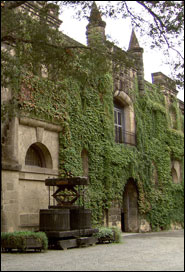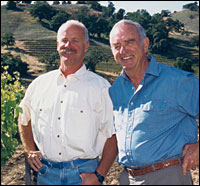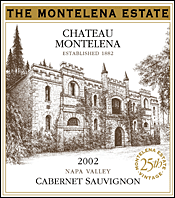The release of Chateau Montelena's 2002 Estate Cabernet Sauvignon is noteworthy for several reasons: the wine is terrific, and its release marks the 25th vintage to be released in the winery's "modern" era. I've been fortunate to taste many of those exemplary Cabernets over the years, and I always come away from the experience impressed by what the wines are--and what they are not. What they are not: over-ripe, over-oaked or over-hyped. What they are: complex but focused, powerful but balanced and refined but ageworthy.
You'd have a hard time finding someone to debate the point that Montelena's Estate Cabernet is one of America's best wines, or even that it belongs near the top of any list of the world's best Cabernet-based wines. Chapters on Montelena were included in both of the books on "greatest" wines published in 2005, namely, "The Great Wines of America" by Paul Lukacs and "The World's Greatest Wine Estates" by Robert M. Parker, Jr.
Lukacs points to the Estate Cab's indisputable greatness when observing that "No one disputes that Chateau Montelena Cabernet is one of America's best. It so obviously belongs in the top ranks of the country's wines that receiving 90+ points from the critics or being included on exclusive restaurant lists no longer raises eyebrows. By now, such recognition is simply expected."
Parker's book refers to the Estate Cab as "a Cabernet Sauvignon superhero" and likens buying it to purchasing a blue-chip stock. He reviews 23 vintages of the wine (2003 - 1977, without entries for the 1988, 1983, 1981 or 1979) and scores every bottling in the 90s. Even wines from purportedly bad vintages earn high scores from Parker, as for example the 93 points awarded the 1998. Parker's high regard for the Estate Cab is especially interesting since his critics often contend that he is a sucker for showboat wines with excessive ripeness and oak, whereas Montelena Cab is both less jammy and less oaky than most of its big-ticket counterparts.
 Although it is surely remarkable that Montelena has been able to stay at the top with Cabernet so consistently, there's really no mystery about how they've done it. Starting with a great vineyard is a given, and that is exactly what Jim Barret purchased after forming a partnership to buy the Calistoga property in 1972.
Although it is surely remarkable that Montelena has been able to stay at the top with Cabernet so consistently, there's really no mystery about how they've done it. Starting with a great vineyard is a given, and that is exactly what Jim Barret purchased after forming a partnership to buy the Calistoga property in 1972.
The site had been established 90 years earlier, when Alfred L. Tubbs purchased 254 acres at the base of Mount Saint Helena (from which the property's name is derived). Tubbs planted vineyards and built the Chateau, and the winery became the seventh largest in the Napa Valley before heading into a decline that began with Prohibition.
Nevertheless, ill-advised amendments to the Constitution have no impact on viticultural potential, and Jim Barret was intent on exploiting that potential to make a great wine right from the outset when planting sixty-five acres of Cabernet Sauvignon along with five acres of Cabernet Franc. He planted his vines onto St. George rootstock, which spared them from the phylloxera scourge of the 1980s and 1990s.
 Barret doesn't try to take credit for prescience on this score, but his choice of St. George was motivated by a willingness to forego big crops in favor of ones with concentration and depth. That preference for quality over quantity--and a willingness to chart an independent course--have marked Montelena's modern era right from the start. Jim Barrett's involvement continues today as owner and managing general partner, with his son, James P. "Bo" Barret working as winemaker.
Barret doesn't try to take credit for prescience on this score, but his choice of St. George was motivated by a willingness to forego big crops in favor of ones with concentration and depth. That preference for quality over quantity--and a willingness to chart an independent course--have marked Montelena's modern era right from the start. Jim Barrett's involvement continues today as owner and managing general partner, with his son, James P. "Bo" Barret working as winemaker.
The estate vineyard is unusually cool for a site near Calistoga, with wide swings in diurnal temperatures that help explain the Cabernet's characteristic purity. The Barretts attribute the wine's complexity to the diverse soils underlying their vineyard (alluvial, volcanic and sedimentary) as well as varied terrain that ranges from flat to fairly steep.
Viticulture is conducted using "only sustainable farming methods," without use of chemical products. Yields are kept low by dry farming and annual crop thinning, and the grapes are picked by hand in the cool of the night. New oak barrels are used relatively sparingly, with the percentage typically running between 20 and 25%. The Estate Cab is aged for up to 22 months in wood before being bottled and aged for another 18 months prior to release.
The consistent excellence of Montelena's Estate Cabernet is reflected by its price, with a suggested retail of $125 for the 2002 (but available for $95 from the winery's website, http://www.montelena.com/). Even more telling is the fact that roughly half of the annual production of the Estate Cab is sold on a futures basis. This unusual practice for an American wine has been followed since 1996, and its continuing viability shows that Montelena has earned an unusually trusting customer base.
Such trust is merited, as was demonstrated to me once again in a mid-March tasting of the 2002 alongside the four previous releases. Tasting notes follow below, but I should also mention that I recently tasted the 1986 (perhaps my favorite of all Montelena's vintages) in a pretty heady pairing with 1986 Chateau Margaux. At the risk of hyper-hyphenating, this head-to-head pairing ran to a neck-and-neck finish, and any property capable of a dead heat with a great vintage of Margaux has made it to the mountaintop.
 Chateau Montelena, Napa Valley (California) Cabernet Sauvignon Montelena Estate 2002 ($95-$125): Already quite complex even at this young age, the 2002 shows remarkably detailed aromas of mocha, woodsmoke, spices and subtle vanilla atop a firm foundation of dark berry fruit. Balance and integration are likewise remarkable, with the result that this is thoroughly enjoyable now with robust food but sure to develop for another two decades. 96
Chateau Montelena, Napa Valley (California) Cabernet Sauvignon Montelena Estate 2002 ($95-$125): Already quite complex even at this young age, the 2002 shows remarkably detailed aromas of mocha, woodsmoke, spices and subtle vanilla atop a firm foundation of dark berry fruit. Balance and integration are likewise remarkable, with the result that this is thoroughly enjoyable now with robust food but sure to develop for another two decades. 96
Chateau Montelena, Napa Valley (California) Cabernet Sauvignon Montelena Estate 2001 ($100-$125): Impressively concentrated and seriously intense, this muscular wine shows very dark color and deep flavors driven by blackberry and cassis notes. The wood component is firm but well tuned to the character of the fruit, with a pure, juicy streak effectively counterbalancing the wine's formidable structure. 94
Chateau Montelena, Napa Valley (California) Cabernet Sauvignon Montelena Estate 2000 ($100-$125): This is one of the two lowest-scoring wines in Parker's estimation (along with the 1982, with both earning 90 points), but by my lights it is a beauty--even if a bit atypical for Montelena. It is less dense than most releases, and though not as intense in aromas or flavors as the norm, it compensates with very expressive, bright berry fruit that is charmingly open, pure and expressive. Relatively tender texture makes this a great choice for a softer cut of meat like prime rib, but plenty of fine-grained tannins will enable it to hang in with any dish--and to hang on for many years to come. 93
Chateau Montelena, Napa Valley (California) Cabernet Sauvignon Montelena Estate 1999 ($100-$125): This baby packs a lot of power, with concentrated blackberry fruit backed by lots of ripe tannins. Although the first impression is one of intensity, the symmetries between structural components and fruit are excellent, and it is already difficult to discern the wood as a distinct element. Lovely accent notes of cocoa and cedar augment the core of dark berries. 94
Chateau Montelena, Napa Valley (California) Cabernet Sauvignon Montelena Estate 1998 ($75-$125): Very complex aromatically and very impressive overall in the context of the vintage, this is not a wine to lay down and forget like most Montelenas, but rather one to crack during the next four or five years. Developed aromas of tobacco leaf, cedar, spices and smoke are lovely and enduringly interesting, and the soft but flavorful fruit provides a lengthy, symmetrical finish. 90